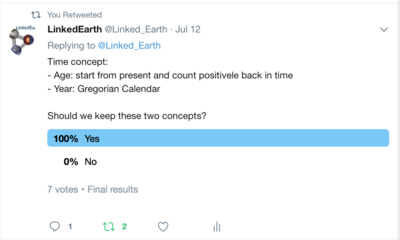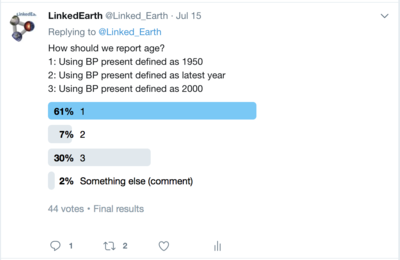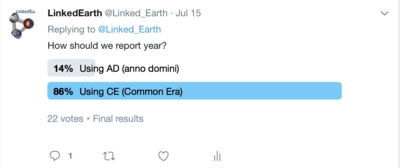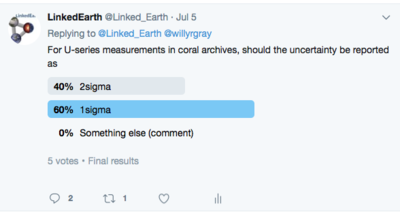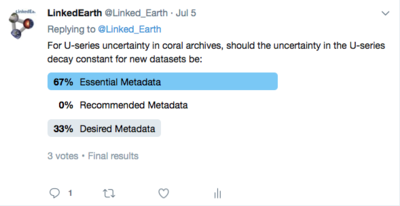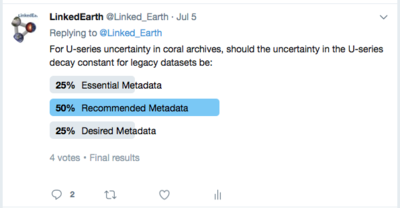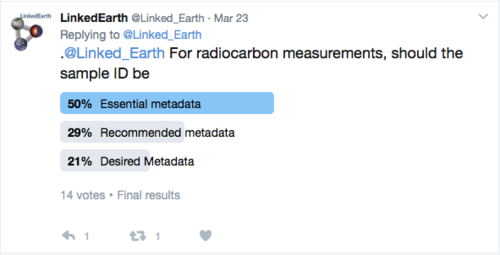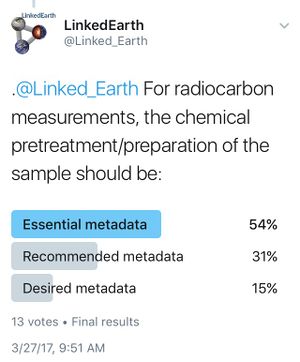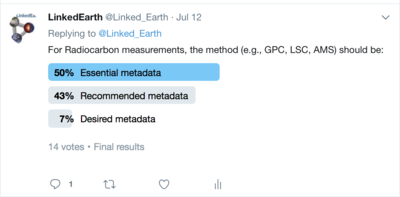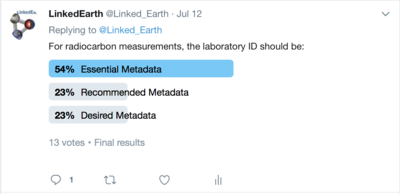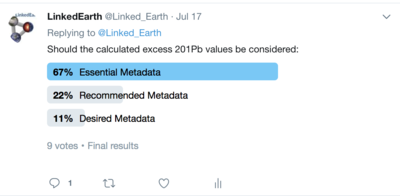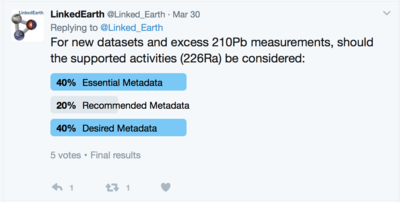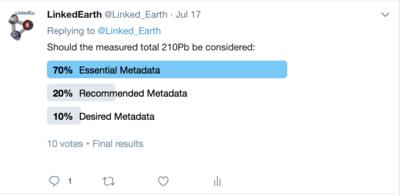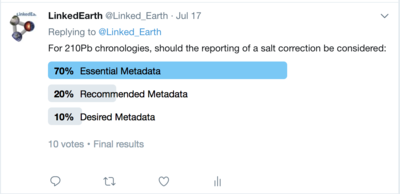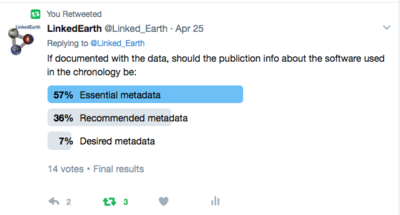Category:Chronologies Working Group
Contents
Overview
In the Linked Earth context, a working group (WG) is a self-organized coalition of knowledgeable experts, whose activities are governed herewith. This page is dedicated to the discussion of data and metadata standards for chronologies, and aims to formulate a set of recommendations for such a standard.
This WG needs to work closely with other WGs, as constraints will vary by archive. Nevertheless, some aspects are common enough that it is worth pursuing some general recommendations, and devise ad hoc adjustments for individual archives if need be. It is recommended that every WG coordinator join this WG to keep track of discussions.
Members
The chronologies Working Group has one coordinator, Christof Pearce (Stockholm University)
Members of 'Chronologies Working Group'
This working group has 18 members.
Specific tasks
We recommend that discussions focus on the following techniques, and explore potential commonalities.
For each chronology type, we recommend:
- structuring discussions around what scientific questions one would want to ask of the data
- listing essential, recommended, and desired information for:
- the age models themselves
- the chronological measurements (ChronData tables, in LiDP/LinkedEarth parlance)
- their uncertainties, and what those numbers correspond to (e.g. 1-sigma or 2-sigma?)
- provide an ideal chronology table, so the community knows what to report and how to report it.
- provide separate recommendations for new and legacy datasets
While it is recognized that most real-word chronologies are of mixed types (e.g. a Holocene lake sediment chronology may blend radiocarbon dates, 210Pb dates, and volcanic ash markers), it is critical to first define guidelines for how to report pure chronologies. Once the foundations are sound, they will be easier to compose together.
Nomenclature
In paleoclimatology, scientists tend to reference the time axis either starting from the present (present often being taken as 1950) and counting positively back in time. In the current LiPD model, this concept is referred to as 'age'. On the other hand, some scientists, especially focusing on the last 2,000 years, use the Gregorian Calendar. In LiPD, this concept is referred to as 'year'.
Note: Do not edit the polls (even for typos) once voting has started as it will reset the vote counts to zero. If a change needs to be made, make an annotation above the old poll (i.e., above the poll tags) and place the new poll below the first one.
You are not entitled to view results of this poll.
If yes, is the current nomenclature adopted by LiPD correct?
Age
You are not entitled to view results of this poll.
Year
You are not entitled to view results of this poll.
Unifying representations
The aforementioned concepts are in fact the same: time. One way to unify its representation is to recognize that all known applications use something of the form:
prefix _ yearlyIncrement _ suffix
- Possible instances of yearlyIncrement are : year, years, annum, annums, etc
- Possible instances of prefix are: none, kilo, mega, giga; this conveys information about the multiplicative factor that needs to be applied to the increments.
- Possible instances of suffix are: none, BP, CE, AD. the suffix conveys information about the direction of time flow, and the reference point (with some ambiguity that needs resolving).
- For years CE, the prefix is none, the yearlyIncrement is years, the suffix is CE. Thus time flows forward from the origin of the Common Era, which is sometimes placed at year 0 (astronomical calendar, or ISO8601), sometimes at year 1. A system for disambiguation is needed (perhaps by attaching an ISO standard).
- For kyr BP the suffix conveys that time flows in reverse from the present day, again defined with some ambiguity as 1950 CE or 2000 CE (see Age poll). The prefix is kilo, indicating that a factor of 1000 needs to be applied.
- For "Ga", the prefix is giga, indicating a billion factor. The increment is "annum", and the suffix is none, indicating implicitly something like BP (where the 1950 or 2000 reference point is immaterial given the time spans involved.
Thus, the direction of time flow (forward or backward) can always been inferred from context; however, the diversity of spelling and abbreviations makes it difficult for machines to guess this, and thus a more disciplined representation would be helpful. For all representations, one might consider an internal representation like `kilo_years_BP`, and an external representation for display purposes like `kyr BP`.
Lastly, we note that the excellent ontology of geologic time by Cox & Richard[1], which deals with >1Ma time scales, does not encompass such distinctions, and thus a new representation is needed.
Recommendations from the literature
The recommendations below are from Govin et al. 2015 [2].
"Future climate-stratigraphic alignments should provide (1) a clear statement of climate hypotheses involved, (2) a detailed understanding of environmental parameters controlling selected tracers and (3) a careful evaluation of the synchronicity of aligned paleoclimatic records. We underscore the need to (1) systematically report quantitative estimates of relative and absolute age uncertainties, (2) assess the coherence of chronologies when comparing different records, and (3) integrate these uncertainties in paleoclimatic interpretations and comparisons with climate simulations."
Absolute dating of aragonitic corals
Dating fossil corals often requires the use of U-series age.
Age calculation and its intrinsic uncertainties
Note: Do not edit the polls (even for typos) once voting has started as it will reset the vote counts to zero. If a change needs to be made, make an annotation above the old poll (i.e., above the poll tags) and place the new poll below the first one.
"In recent years, most ages have been obtained through high precision TIMS or MC-ICP-MS measurements are are generally given with a ±2σ. Earlier, they were mostly obtained through alpha particle counting and generally cited with a ±1σ uncertainty. [2]"
You are not entitled to view results of this poll.
"Some vagueness persists with respect to the way quoted uncertainties include or not all potential sources of analytical errors (internal vs external precision), which makes direct comparison of databases somewhat hazardous. [2]"
"Moreover, radiometric age equations include decay constants of all concerned isotopes, which are known with some uncertainty. The comparison of such U-series ages to any other time scale, such as glaciological ages, astronomically-tunes ages and other radiometric ages, requires the U-series decay constant uncertainties to be carried into the final age error calculation [2]"
You are not entitled to view results of this poll.
You are not entitled to view results of this poll.
"Should be propagated through full uncertainty analysis in published dating table. But if not there, it's easy to figure out by pub date."
Dating of speleothems
Absolute dating and stratigraphic markers
Speleothems can be absolutely dated over the last 600ka with the U-Th methodology [3], with a dating uncertainty better than 0.5% [4] [5] [6].
Recommendation from Govin et al. (2015) [2]
"Ideally, new [spleothem] records should present growth rates as high as possible and numerous U-Th dating points in order to (1) reduce dating uncertainty, (2) enhance the robustness of radiometric chronologies on centennial to millennial time scales, (3) maximize constraints on the 'accordion effect' induced by growth rate changes and (4) optimize the assessment of the synchronicity between records. [2]"
Chronologies in marine sediments
| Method | Hypotheses | Age Uncertainties | Strengths | Limitations/difficulties | Recommendation |
|---|---|---|---|---|---|
| Radiocarbon | Reservoir age correction is known and not changing over time | See #Radiocarbon | Absolute chronologies | Reservoir Age correction | |
| Synchronization of tephra horizons | Correct identification of the same tephra in different archives |
|
|
|
High potential of synchronization |
| Synchronization of geomagnetic excursions and of relative paleointensity records | Global signal | Potential to synchronize paleointensity to cosmogenic isotopic records from ice cores |
|
Method suitable for local to global synchronization when sediments pass criteria of paleomagnetic reliability | |
| Benthic foraminifera δ18O alignment | In-phase benthic δ18O variations |
|
Common tracer: many available records | Diachronous deep-water temperature and δ18O changes across water-masses | Method suitable between sites located within the same water mass |
| SST alignment to ice cores | In-phase high-latitude sea surface and air temperature changes | High-resolution ice core records for the last 800 ka |
|
Method suitable for North Atlantic and Southern Ocean sites | |
| Marine alignment to speleothems | In-phase regional changes in marine (e.g., SST, salinity, pollen) and continental (e.g., rainfall amount) tracers |
|
|
Method suitable for sites (mostly from tropical and mid-latitude regions) located close to well-dated speleothems with well-understood tracers |
Tie-point chronologies
Radiocarbon
The following came from P. Reimer by way of T. Guilderson.
Key references: Stuiver & Polach [1977] [7] and Reimer et al., [2004] [8]
metadata
| Metadata | Essential (E)/Recommended(R)/Desired(D) | Reason | Added by (optional) |
|---|---|---|---|
| Sample ID | E | Allows to provide a unique identifier to the sample | Deborah Khider (talk) 15:17, 15 March 2017 (PDT) on behalf of T. Guilderson |
| Type/Matrix | E | Deborah Khider (talk) 15:17, 15 March 2017 (PDT) on behalf of T. Guilderson | |
| Location (lat/lon/alt or sample depth) | E | Deborah Khider (talk) 15:17, 15 March 2017 (PDT) on behalf of T. Guilderson |
Note: Do not edit the polls (even for typos) once voting has started as it will reset the vote counts to zero. If a change needs to be made, make an annotation above the old poll (i.e., above the poll tags) and place the new poll below the first one.
You are not entitled to view results of this poll.
You are not entitled to view results of this poll.
Polls on whether location information should be essential, recommended or desired metadata for new dataset can be found here for new datasets and here for legacy datasets.
Reporting the Radiocarbon measurements
| Metadata | Essential (E)/Recommended(R)/Desired (D) | Reason/Notes | Added by (optional) |
|---|---|---|---|
| Chemical pretreatment/preparation | E | oxidation, chemical leach (%), a/b/a, soxhlet, ultrafiltration, none, etc | Deborah Khider (talk) 15:37, 15 March 2017 (PDT) on behalf of T Guilderson |
| Method | E | GPC, LSC, AMS, etc | Deborah Khider (talk) 15:37, 15 March 2017 (PDT) on behalf of T Guilderson |
| Laboratory ID# | E | eg. OS####; CAMS####; QUB#### | Deborah Khider (talk) 15:37, 15 March 2017 (PDT) on behalf of T Guilderson |
| δ13C ratio actual/estimated (PDB/V-PDB) | R | Note, the AMS measured 13C has low precision (a few per mil, compared to IRMS). Most AMS labs do NOT report the machine measured 13C value because it is frequently misused. This should be estimated as per SP77 [7] or an IRMS-based value/estimate. | Deborah Khider (talk) 15:37, 15 March 2017 (PDT) on behalf of T Guilderson |
| Conventional radiocarbon age as years BP | E | Note, that by definition, conventional radiocarbon age is the Libby based age. | Deborah Khider (talk) 15:37, 15 March 2017 (PDT) on behalf of T Guilderson |
| one-sigma standard deviation | E | one-sigma standard deviation | Deborah Khider (talk) 15:37, 15 March 2017 (PDT) on behalf of T Guilderson |
| F14C (13C and background correction applied) | E | This is slightly different than Stuiver and Polach [7] who have "D14C" as the optional parameter.
We suggest the inclusion of the background and d13C corrected Fraction modern (F14C) as it is the primary reported value. In the past there has been some inconsistencies in the literature/laboratories with regards to fraction modern. By using/requesting F14C you will be explicitly requesting 13C and background corrected Fraction Modern (aka F14C, as per Reimer et al.[2004]) as intended by SP77.
|
Deborah Khider (talk) 16:13, 15 March 2017 (PDT) on behalf of T Guilderson |
| Correction applied to radiocarbon date prior to, or during conversion to calibrated age | |||
| Marine Reservoir effect | |||
| Marine reservoir age, , ± one-sigma sd (or square root of the variance) uncertainty, reference/source | E | Deborah Khider (talk) 16:13, 15 March 2017 (PDT) on behalf of T Guilderson | |
 value, ± one-sigma sd (or square root of the variance) uncertainty, reference/source value, ± one-sigma sd (or square root of the variance) uncertainty, reference/source |
E | Deborah Khider (talk) 16:13, 15 March 2017 (PDT) on behalf of T Guilderson | |
| hard/soft water effect: value, ± one-sigma sd (or square root of var) uncertainty, reference/source | E | Deborah Khider (talk) 16:13, 15 March 2017 (PDT) on behalf of T Guilderson | |
| other corrections: value (14C years), ± one-sigma sd (or square root of var), reference/source | E | Deborah Khider (talk) 16:13, 15 March 2017 (PDT) on behalf of T Guilderson | |
| Calibration or conversion to calibrated ages |
As of present, the international radiocarbon community recommends the use of the INTCAL13 (aka Marine 13[9]) and SHCAL13 [10] data products. Calibration of post-bomb (post 1954/1957) samples should also include the calibration data-set utilized, description/reference of any corrections applied, and the software/algorithm utilized to convert the F14C data to years AD. |
Deborah Khider (talk) 16:13, 15 March 2017 (PDT) on behalf of T Guilderson | |
Note: Do not edit the polls (even for typos) once voting has started as it will reset the vote counts to zero. If a change needs to be made, make an annotation above the old poll (i.e., above the poll tags) and place the new poll below the first one.
You are not entitled to view results of this poll.
You are not entitled to view results of this poll.
You are not entitled to view results of this poll.
You are not entitled to view results of this poll.
You are not entitled to view results of this poll.
You are not entitled to view results of this poll.
You are not entitled to view results of this poll.
You are not entitled to view results of this poll.
You are not entitled to view results of this poll.
You are not entitled to view results of this poll.
Lead
Proposed standards from Doug Hammond (University of Southern California).
| Metadata | Description | Essential (E)/ Recommended (R)/ Desired (D) |
|---|---|---|
| calculated excess 210Pb values | Total - supported | E for both New and Legacy datasets |
| 226Ra | The supported 210Pb | D for both new and legacy datasets |
| Total 210Pb | D for both new and legacy datasets | |
| Whether a salt correction is made | D for both new and legacy datasets | |
| Porosity | necessary to do a salt correction | D for both new and legacy datasets |
| Measurement methodology | alpha spectrometry, gamma spectrometry... | R for both new and legacy datasets |
| Units | Recommend to report units in Bq/kg | |
| Depth | A way to locate where on the archive the measurements was made | E |
| mid-depth | E for both new and legacy datasets | |
| interval top/bottom | R for both new and legacy datasets | |
| core collectionDate | Necessary to convert the excess 210Pb values to calendar age
Recommend to correct the reported activities to the collectionDate |
E for both new and legacy datasets |
| Methodology used to calculate age | E for both new and legacy datasets |
The same standards (excluding supporting measurements, which do not apply) are proposed for 137Cs measurements which are often made alongside 210Pb.
Note: Do not edit the polls (even for typos) once voting has started as it will reset the vote counts to zero. If a change needs to be made, make an annotation above the old poll (i.e., above the poll tags) and place the new poll below the first one.
You are not entitled to view results of this poll.
You are not entitled to view results of this poll.
You are not entitled to view results of this poll.
You are not entitled to view results of this poll.
You are not entitled to view results of this poll.
You are not entitled to view results of this poll.
You are not entitled to view results of this poll.
You are not entitled to view results of this poll.
You are not entitled to view results of this poll.
You are not entitled to view results of this poll.
U-series
A standard was recently proposed by Dutton et al [2017][11]. We suggest to re-use it wholesale.
Layer-counted chronologies
Comboul et al[12] argue that it is critical to report uncertainties in layer-counted chronologies, and that these can be expressed in terms of an undercounting and overcounting rate. However, there needs to be agreement about how to measure and report this rate for various archives.
Varves
Growth rings
Trees, corals, speleothems
Tree-rings typically provide an absolute chronology but there needs to be the facility to also work with 'floating' chronologies anchored typically by radiocarbon. A hybrid dendro-radiocarbon chronological framework should be supported.
Tree-rings data can also be stored at subannual level e.g. with early and latewood parameters. These are typically stored as two different data series as they are normally used to reconstruct different climatic parameters. In chronological terms these datasets represent portions of the year but precisely which portions depends on the species and location. In the southern hemisphere the earlywood will typically grow in the final months of the year and the latewood the first months of the following year. For paleoclimate reconstructions it's therefore essential to include metadata regarding the months each data point covers.
A convention that continues to cause confusion when representing dendrochronological data is the use of the astronomical calendar. The astronomical calendar includes the year 0 so matches the AD calendar, but is one year different in the BC period. Astronomical dates are easier to handle in statistical analyses but have been erroneously quoted as BC years in even some very prestigious articles. Whatever method is used, it should be clear and consistent.
Ice layers
Role of flow models.
Age-modeling software
Content:
- method (e.g. Bacon, OxCal, BChron, BAM)
- version
- parameters
Note: Do not edit the polls (even for typos) once voting has started as it will reset the vote counts to zero. If a change needs to be made, make an annotation above the old poll (i.e., above the poll tags) and place the new poll below the first one.
You are not entitled to view results of this poll.
You are not entitled to view results of this poll.
You are not entitled to view results of this poll.
You are not entitled to view results of this poll.
You are not entitled to view results of this poll.
Relative chronologies
Example of relative chronologies include benthic δ18O alignment, paleomagnetic data...
| Metadata | Essential (E)/Recommended(R)/Desired (D) | Reason/Notes | Added by (optional) |
|---|---|---|---|
| Category:MeasuredVariable_(L) | E | δ18O, magnetic direction/intensity | Deborah Khider (talk) 12:16, 14 September 2017 (PDT) |
| The target | E | Which record was used as target for the alignment? | Deborah Khider (talk) 12:16, 14 September 2017 (PDT) |
| Labeling features | E for manual alignment/D for automated alignment | Which features of the records were used as tie points | Deborah Khider (talk) 12:16, 14 September 2017 (PDT) |
| Method | E | Either the software employed or if by hand, the fit strategy | Deborah Khider (talk) 12:16, 14 September 2017 (PDT) |
| Flag for mixed chronologies | R | Deborah Khider (talk) 12:16, 14 September 2017 (PDT) |
You are not entitled to view results of this poll.
You are not entitled to view results of this poll.
You are not entitled to view results of this poll.
You are not entitled to view results of this poll.
Polls
Note: Do not edit the polls (even for typos) once voting has started as it will reset the vote counts to zero. If a change needs to be made, make an annotation above the old poll (i.e., above the poll tags) and place the new poll below the first one.
Here are polls that the group might want to consider:
For LEGACY DATASETS:
You are not entitled to view results of this poll.
References
- ↑ Cox, S. J. D., and S. M. Richard (2015), A geologic timescale ontology and service, Earth Science Informatics, 8(1), 5–19, doi:10.1007/s12145-014-0170-6.
- ↑ 2.0 2.1 2.2 2.3 2.4 2.5 2.6 Govin. A., E. Capron, P.C. Tzedakis, S. Verheyden, B. Ghaleb, C. Hillaire-Marcel, G. St-Onge, J.S. Stoner, F. Bassinot, L. Bazin, T. Blunier, N. Combourieu-Nebout, A. El Ouahabi, D. Genty, R. Gersonde, P. Jimenez-Amat, A. Landais, B. Martrat, V. Masson-Delmotte, F. Parrain, M.-S. Seidenkrantz, D. Veres, C. Waelbroeck, R. Zahn, 2015. Sequence of events from the onset to the demise of the Last Interglacial: Evaluating strengths and limitations of chronologies used in climatic archives. Quaternary Science Reviews, 129, 1-36, doi:10.1016/j.quadcirev.2015.09.018.
- ↑ Helmstrom, J., 2006. U-Th dating of speleothems with high initial 230Th using stratigraphical constraint Quaternary Geochronology, 1, 289-295.
- ↑ Dorale, J., Edwards, R.L., Alexander Jr., E.C., Shen, C.-C., Richards, D., Cheng, H., 2004. Uranium-series dating of speleothems: current techniques, limits, & applications. In: Sasowsky, I., Mylroie, J. (Eds), Studies of Cave Sediments, Springer, US, pp. 1777-197. http://dx.doi.org/10.1007/978-1-4419-9118-8_10.
- ↑ Li, H.-C., Ku, T.-L., You, C.-F., Cheng, H., Edwards, R.L., Ma, Z.-B., Tsai, W.-s, Li, M.-D., 2005. 87Sr/86Sr and Sr/Ca in speleothems for paleoclimate reconstruction in Central China between 70 and 280kyr ago. Geochimica and Cosmochimica Acta, 69, 3933-3947. http://dx.doi.org/10.1016/j.gca.2005.01.009.
- ↑ Cheng, H., Edwards, R.L., Broecker, W.S., Denton, G.H., Kong, X., Wang, Y., Zhang, R., Wang, X., 2009. Ice age terminations. Science 326, 248-252. http://dx.doi.org/ 10.1126/science.1177840.
- ↑ 7.0 7.1 7.2 Minze Stuiver and H. A. Polach, 1977. Discussion: Reporting of 14C Data. Radiocarbon 19, 3, 355-363.
- ↑ Paula J. Reimer, T. A. Brown, and R. W. Reimer, 2004. Discussion: Reporting and calibration of post-bomb 14C Data. Radiocarbon, 46, 3, 1299-1304.
- ↑ P. J. Reimer et al., 2013. INTCAL13 and MARINE13 Radiocarbon age calibration curves, 0-50,000 years CAL BP. Radiocarbon, 55, 1869-1887.
- ↑ A. G. Hogg, et al., 2013. SHCal13 Southern Hemisphere calibration, 0-50,000 years cal BP. Radiocarbon 55, 1889-1903.
- ↑ A. Dutton, K. Rubin, N. McLean, J. Bowring, E. Bard, R.L. Edwards, G.M. Henderson, M.R. Reid, D.A. Richards, K.W.W. Sims, J.D. Walker, Y. Yokoyama, Data reporting standards for publication of U-series data for geochronology and timescale assessment in the earth sciences, Quaternary Geochronology, Volume 39, April 2017, Pages 142-149, DOI
- ↑ Comboul, M., J. Emile-Geay, M. N. Evans, N. Mirnateghi, K. M. Cobb, and D. M. Thompson (2014), A probabilistic model of chronological errors in layer-counted climate proxies: applications to annually banded coral archives, Climate of the Past, 10(2), 825–841, doi:10.5194/cp-10-825-2014
Pages in category "Chronologies Working Group"
This category contains only the following page.


